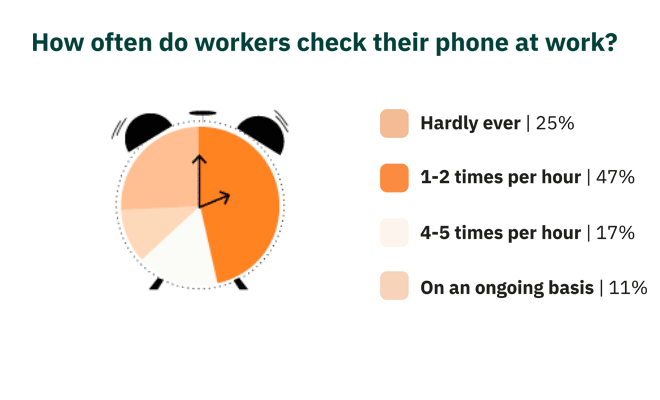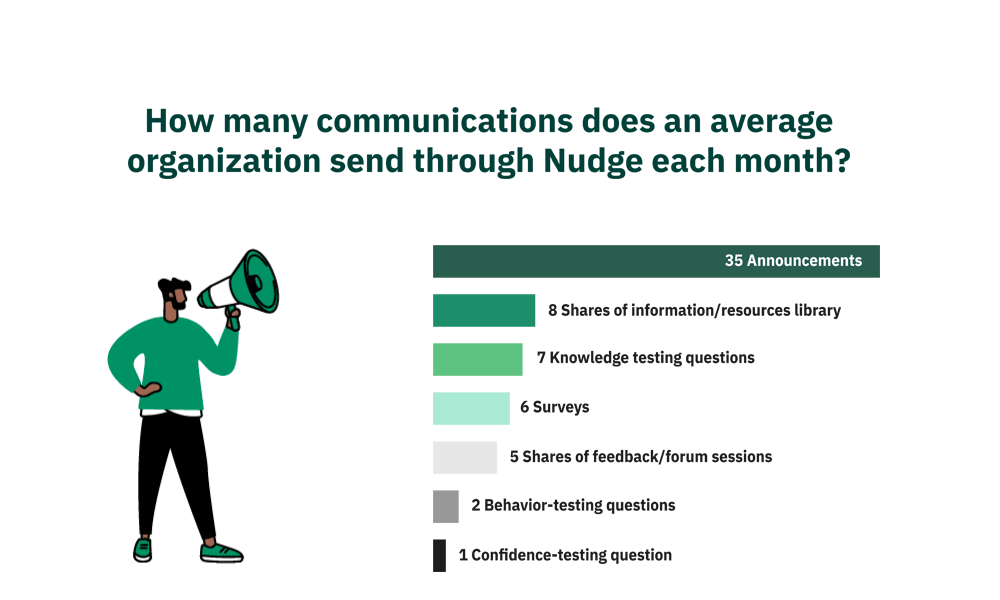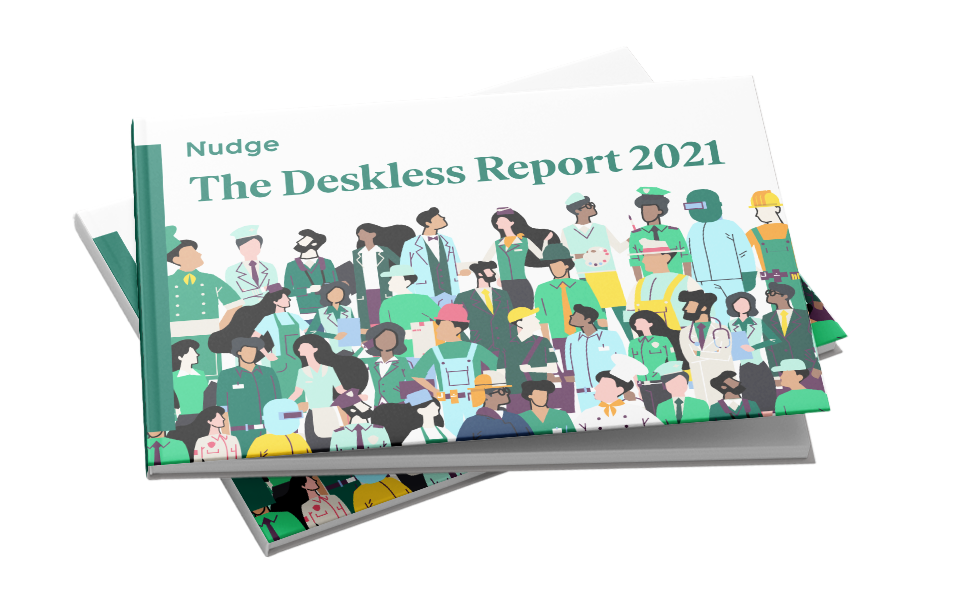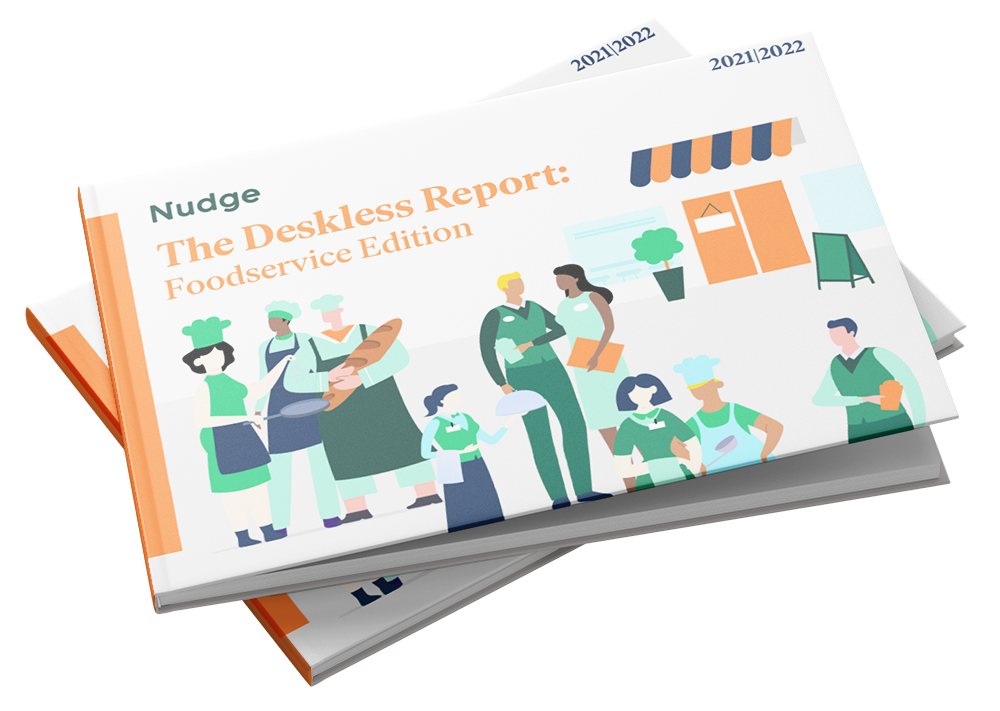Welcome to the inaugural year of The Deskless Report. The following research explores who deskless workers are, what drives them, and what they desperately need. But we’re also looking at deskless leaders as well, including what keeps them up at night, how they’re prioritizing the employee experience, and what they’re investing in next year and beyond. That’s where this report offers a unique viewpoint: We’re exploring the disconnect between workers and leaders – the gaps between what workers want and what head office is providing.
In The Deskless Report, we’ll answer a few simple questions about the state of the deskless workforce – the same questions we’ll strive to answer for years to come. We hope you enjoy our findings and that they spark some new ideas and conversations at your organization.
What’s the state of the deskless workforce?
It’s a question we ask ourselves every year, but this year is different. Coming out of the pandemic, frontline and deskless organizations have been forever changed. There’s a need for operational agility like never before. The expectations of consumers and guests have been heightened to a level we’ve never seen. There’s a labor shortage impacting every industry. And, of course, the deskless workforce is finally in the spotlight as the essential, incredibly hardworking employees that they’ve always been. These workers can do incredible things with the right tools, knowledge, and support.
So, what’s the state of the deskless workforce? As you’ll see in the following report, we have some work to do. As we come out of this challenging period, it’s time to take a hard look at who this workforce is, what they want, and how we can support them to help us rebuild – and thrive.
– Lindsey Goodchild, Nudge CEO

Who are deskless workers?
Who are deskless workers? They’re the driving force behind some of the biggest industries in the world: retail, foodservice, hospitality, manufacturing, facilities management, and others. They’re on the frontlines, delivering a memorable customer experience. They’re behind the scenes, keeping environments safe and clean. They’re on the assembly line, behind the counter, in the truck. And, as a result, they don’t sit behind a computer to do their job.
And despite the fact that this group makes up about 80% of the workforce (we’re talking almost 3 billion employees!), there’s traditionally been very little attention given to deskless workers when it comes to enabling their performance through technology and employee experience.
Why? Unfortunately, organizations haven’t kept apace with the evolving needs of their deskless workers. Not unlike their deskbound compatriots, deskless workers are driven by a complex cocktail of career goals, compensation, a sense of purpose, and a strong community. In fact, 68% of worker respondents said they regularly think about career progression and goals, and 55% said that a sense of purpose at work makes them feel engaged and motivated. Learning more about these driving forces is the first step in engaging and empowering these workers to thrive.

SPOTLIGHT:
The quest for employee community
While the deskless worker’s desire to find a sense of purpose provides a lot of insight into how this workforce can be engaged and retained, it’s their quest for a sense of community that’s perhaps even more telling.
Of the workers polled, 38% said having a strong community at work makes them feel engaged and motivated.This is a challenge with deskless workers, especially in frontline industries like retail and foodservice, where individual locations only employ a handful of workers, but the company as a whole numbers in the hundreds of thousands.
There’s a gap there. While 78% of workers said they feel connected to the coworkers at their location, 60% said they would like a stronger community with the employees outside their location. And, among the top ways workers said they’d feel more connected to other coworkers is communication.
What keeps deskless leaders up at night?
In talking to organizational leaders responsible for frontline and deskless workers, some of the hurdles they face vary by industry – but many of the biggest challenges are universal. For example, turnover was the number one challenge selected by deskless leaders (more on that below). Revenue and productivity are also top of mind; 17% and 15% of leaders chose them as their top challenge, heightening the struggle of organizations to return to “normal” post-pandemic.
Leaders also indicated communication is a major challenge; in fact, they said it’s the number one barrier between head office and workers. More specifically, the biggest communication challenges facing leaders are knowledge retention, and finding ways to share real-time info – two critical hurdles to overcome for any frontline organization.
According to deskless leaders, the #1 barrier between head office and workers is:
Communication
“Investing in the frontline when retail is in its current state is a winning game plan. You have to remove communication barriers between head office and the store itself.”
– Frederick Lecoq | Chief Marketing Officer, Sporting Life Group
SPOTLIGHT:
Turnover
The worst labor crisis in 30 years hit frontline industries after the lockdowns lifted, caused by everything from government subsidies and employee burnout to a heightened need for meaningful contribution among workers.
Even now, as the crisis continues to shift, turnover is still top-of-mind for deskless leaders – and workers. In fact, 36% of workers polled said they currently want to quit their jobs. That number jumps to 38% for foodservice workers and 40% for facilities management workers.
When asked what would make them leave their current jobs, many workers said finding a job with better pay, benefits, or work/life balance. But the second most common answer was poor communication. Here, we see synergy between deskless leaders and workers – both see communication as a problem that needs fixing. Badly.
“Nothing is more important than hiring the right people and getting the right people in the door.”
– Mike Fiato | SVP Guest Experience, Eurest
What’s the state of deskless worker communication?
One of the most interesting outcomes of these surveys with deskless leaders and workers was the level of disconnect. While 86% of leaders say they’re sending meaningful communications to their workers, 59% of workers say the communications they receive aren’t useful. And 44% of leaders say they share information daily, but only 24% of workers agree.
There’s a major disconnect on how communications are shared, when communications are shared, and whether those communications are valuable. That’s a problem.
Effective employee communication has the power to drive a wide range of business outcomes far beyond the standard HR KPIs. Think revenue, turnover, CX, operational consistency… the list goes on. Unfortunately, far too few organizations are actually leveraging their communication strategies to their full potential – and risk losing their employees as a result.
How information is shared
The communication channels that deskless organizations use is crucial to their strategy. One of the biggest mistakes that companies make is leveraging the same channels used for deskbound workers, like email or an intranet site.
Unfortunately, both workers and leaders indicated that email is still the top communication channel being used. While these types of channels are still suitable for employees that have consistent access to a computer all day, they present a number of challenges to frontline and deskless workers. They aren’t as accessible during work hours, and they don’t allow for the two-way communication that is so vital to workers.
Both leaders and workers listed “verbal updates from manager” as the second-most-used communication channel. Here, too, we see a problem. Relying on floor managers to disseminate crucial information to their staff can result in bottlenecks, inconsistencies, and retention issues.
Looking at these responses, it’s no wonder that the biggest challenges leaders said their organization faces when it comes to communicating with their frontline, are knowledge retention, and sharing real-time information.
“In-store huddles and intranet updates alone weren’t going to be sustainable this year. We knew we had to equip our store teams with the latest information and effectively respond to the market.”
– Tania Walsh | Manager, Digital Communications Strategy, TELUS
SPOTLIGHT:
BYOD policies
BYOD, or bring your own device, is a company policy that allows workers to bring their own smartphones or other devices to use at work. These policies are growing in popularity but sometimes come against resistance from head office due to concerns with security
and productivity.
When it comes to these policies, we again see a disconnect between workers and leaders. While 82% of workers polled said phones are permitted during shifts, only 63% of leaders agreed.
Whether or not it’s permitted, 91% of workers are using their phones at work; 47% of workers said they check their phone 1-2 times per hour, and 17% said they check their phones 4-5 times an hour. However, when asked why they’re checking their phones at work, the resounding answer was “for work”. Over 60% of workers said they’re using their phones during shifts for work-related communication, or finding work-
related information.

What information is shared
One of the most telling statistics in this entire report is in this section. When asked, “What type of communication do dislike?” the top answer from our worker respondents was “None of
the above.”
In other words, you can’t over-share with your workforce. They’re starving for information. While 53% of workers said they’re receiving company updates, 40% said they want more company updates. Also, 36% of workers said they’re receiving updates on products and services, but 32% said they want more. The same is true of company vision and mandate – while 82% of workers said they have a clear sense of their company’s vision, 63% of respondents still said they want to know more.
When information is shared
When asking deskless workers and leaders about the frequency of the employee communications being shared, we again see a disconnect. While 44% of leaders said that communications are shared throughout their organization every day, only 24% of workers agree. Meanwhile, 11% of workers said that they receive communications less than once a month.
Also interesting is when this information gets consumed by workers. Whether or not organizations have a BYOD (bring your own device) policy in place, 60% of workers are reading employee communications during their shift. And it’s no surprise – when the information being shared is product information, SOPs, or customer feedback, workers need to access it in real-time, not hours later.
NUDGE INSIGHTS
How organizations use Nudge
When it comes to the frequency of employee communications being shared and consumed, there are some fascinating insights we can learn from our own usage data. Our digital communication platform shares bite-sized information with frontline and deskless workers where they’ll actually read it: their phones!
While some organizations are hesitant to implement a BYOD policy, what the data shows is that workers are getting the information they need quickly and efficiently. In fact, the average Nudge user only spends 10 minutes in the app each week.
Nudge data also shows the types of communications that organizations are sending out each month – and announcements lead the pack, by far. Again, that’s where the bite-sized information comes in. Organizations share announcements to send short-and-sweet information to their teams in real-time, which means workers are getting what they need faster and easier – and can get back to doing their jobs.
Average time spent in Nudge, per worker
PER DAY
2.8 min
PER WEEK
10.1 min

How effective are employee communications?
While 86% of leaders feel they’re sending out meaningful, quality communications, workers disagree. In fact, 59% of workers said the communications they receive are somewhat to not-at all useful, which might explain why 40% of workers said they only read the communications sent to them sometimes – or not at all.
As you can see from some of the worker insights below, having the right channels and frequency in place is a big part of achieving that effectiveness. Bu another part of the process is monitoring it, and that’s where we see leaders fall short. When leaders were asked the methods they use to monitor the effectiveness of their communication programs, the most common answer was “None” or “Not sure”. Without ways to continually monitor and improve your programs, the effectiveness of your employee communications will be continually at risk.
“I want to be communicated via app and email so that we can always refer to something in case we forget it.”
– Retail worker
“[Receiving communications] often and frequently and completely are vital to our success!”
– Facilities management worker
What’s the state of deskless worker feedback?
Your workforce can tell you so much.
They can tell you what the customer is thinking, doing, and buying. They can tell you the best way to drive sales, the fastest way to execute tasks, and the most effective way to mobilize on promotions and programs.
They’re a wealth of incredibly vital information… if you ask them.
Having fast and easy, real-time feedback channels for your workforce is make-or-break for organizations looking to stay agile and responsive in an ever-changing world. It’s also a crucial part of engaging and empowering your workforce, which can do wonders for retention and loyalty. Unfortunately, while 78% of deskless leaders we polled said their organization is fostering a strong feedback culture, 39% of workers don’t feel heard. Only 24% of workers said their organization asks them for feedback often;
76% of workers said they’re asked only sometimes – or never.
In other words, there’s an untapped opportunity.
Why is feedback so important?
While traditionally, employee feedback might have been seen as HR territory, there are actually so many business benefits that come from fostering a (two-way) feedback culture. It’s a great way to collect customer intelligence, identify protocols or processes that could be more efficient, and find best practices that can drive revenue, improve CX, and more. In fact, 68% of workers polled said they have opinions on how to make their organization better or more profitable. For many industry-leading frontline organizations, feedback is their secret weapon.
But also, deskless workers want to feel heard. Of the workers polled, 67% said that feedback is very or extremely important to them. Investing in feedback empowers employees to feel connected to their business as a whole, and makes them feel invested in helping to drive business outcomes. Unfortunately,
39% of workers don’t feel heard by their organization. We’ll delve into the channels, frequency, and types of feedback workers want in the coming sections, but one thing is clear: Workers want their voices to be heard.
“The feedback loop is where we learn as an organization: It looked great on paper, it didn’t land exactly as we had hoped, and now we know what we need to do.”
– Rachel Huckle | Chief Retail Officer, Staples Canada
How (and when) feedback is collected
When it comes to employee feedback programs, the disconnect might be less about whether a program is in place, but rather how effective it is. While 84% of leaders said that their company has channels in place for collecting feedback, only 24% of workers said their company asks them for feedback often.
A common challenge in deskless organizations is making sure that the feedback channels you have in place are easy to find, simple to use, and top-of-mind. The numbers we’re seeing suggest that even if organizations are succeeding at getting feedback channels going, they might not be channels that are useful for workers.
Case in point: The top three feedback channels that workers said their organizations use were surveys, conversations with managers, and email. This is a problem. Of the three feedback channels listed by workers, none of them offer opportunities to send real-time feedback directly to head office. And none of them offer opportunities to crowdsource ideas or best practices with the employee community as a whole.
Types of feedback collected
When it comes to feedback, the “what” is just as important as the “how”: the specific kinds of feedback workers are being tapped for. Workers were polled on what types of feedback they’re asked for, and what types they’d like to provide. The responses were very similar, which again suggests that while some feedback programs are in place, workers want more. They want to give more feedback about efficiency/protocols, more health and safety concerns, more feedback about their managers.
One interesting feedback type was “Knowledge gaps.” Only 20% of workers said they’re asked for this feedback, and 30% said they’d like to provide this feedback. Identifying knowledge gaps is incredibly valuable when it comes to auditing your overall communications programs at scale – and monitoring workforce readiness for upcoming promos, launches, and key events. And the fact that workers want to share these gaps speaks volumes about how hungry they are for information.
What’s happening in 2022?
This report began by saying that we have some work to do. And here, we see that leaders seem to agree: 65% of leaders plan to invest more energy or budget into employee experience in 2022, and 28% of leaders plan to invest more money in communications or feedback.
These are exciting numbers, especially considering 17% of leaders said they don’t have any kind of employee communications program in place, and 18% said they currently have no budget allotted for employee communications. Are these numbers on the lower side? Yes. Should they be much, much lower? Also, yes. Throughout this report, we’ve seen workers being very clear on what they want when it comes to communication, feedback, and the overall employee experience: They want more.
“We’re grateful to have had the foresight to invest in technology that would connect our brand and franchises with frontline staff, and are finding it more useful than ever now that we’re adapting so rapidly to modifications of COVID-19 training.”
– Steve Rothenstein | Senior Director of Franchising, Dippin’ Dots & Doc Popcorn
Participate in The Deskless Report 2022
The Deskless Report is an annual look at the state of the deskless workforce, the challenges facing deskless leaders, and the technology that’s driving change. Want to take part in next year’s survey for The Deskless Report 2022? Participants enjoy a chance to have their voices heard – plus, early access to the results of our research! Click here to add your name to the list.
Final thoughts
As I explore this report, a few things jump out at me. First, the needs of deskless workers have evolved. They have career goals, a hunger for community, and opinions about how to make organizations better. To get the most out of workers, we need to treat them like partners – like vital assets they are.
It’s time for deskless organizations to finally shake off the deskbound legacies that have stuck around for far too long. Time and time again, we see deskbound technology causing problems in deskless organizations: it’s too slow, too computer-focused, too ill-suited to the needs of the deskless worker. For deskless organizations to truly thrive, they need to embrace the two-way, real-time information sharing that their workers desperately need.
I can’t wait to see what the next year brings.
– Jordan Ekers, Nudge COO
Download industry reports
Looking for more? Download our industry reports for in-depth insights into the retail and foodservice industries.

Download your copy of
The Deskless Report!
Download the report for additional insights, including key findings, methodology, and more. (You can also download industry reports here!)


